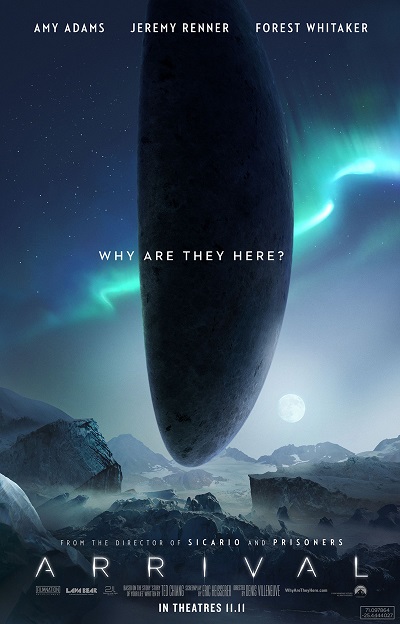
Content note: Minor spoilers.
I’m behind on movies, but I’m trying to catch up on the ones I missed when they were in theaters. The 2016 film I most wanted to see was Arrival, and it was worth the wait.
Arrival is a first contact sci-fi story, based on Ted Chiang’s novella “Story of Your Life”. It begins with twelve huge ovoid spaceships appearing silently, simultaneously, at twelve locations across the Earth. Every eighteen hours, a hatch opens in each of the ships, and the human beings daring enough to venture inside find themselves in a chamber where they come face-to-face with the alien pilots.
The enigmatic aliens, who are soon dubbed “heptapods”, look like giant squid, moving about gracefully on seven prehensile tentacles. The seemingly impossible technology of their ships makes it clear that their science is light-years beyond ours. But they don’t speak our language and we don’t speak theirs, and while they’re willing to interact with human beings, they don’t seem especially interested in explaining themselves.
The main character is Dr. Louise Banks (Amy Adams), a linguist tapped by the military to figure out how to communicate with the aliens so we can find out why they’ve come and what they want from us. Are they scientists studying a primitive planet? Tourists on safari? Or something worse? As the shock of their arrival touches off panic all over the world, the suggestion is inevitably made that they might be surveying the planet for colonization.
However, it’s no spoiler to say that Arrival goes in a very different direction than the usual Hollywood ray-guns-and-bug-eyed-monsters fare. Like the story it’s based on, it soon becomes something more reflective, philosophical, and emotionally resonant, a meditation on the nature of time and free will. Above all else, it’s a deeply thoughtful movie, the kind I didn’t think could be made anymore in this era of CGI explosions and tentpole blockbusters.
As Dr. Banks learns to communicate with the heptapods, she finds that they conceive of time and causality very differently than we do, and their language reflects this. Their writing system is made of glyphs that look like circles blotched and spattered with ink. But each one can express a multitude of complex ideas, even though the heptapods can produce them instantaneously. She compares the speed and complexity of thought required to writing a sentence with two hands simultaneously, one starting at the beginning, the other at the end, and the two meeting seamlessly in the middle. It’s a language that requires you to know exactly what you’re going to say before making the first stroke. As she becomes increasingly fluent in it, she finds the heptapods’ mindset seeping into her head, even as she’s increasingly troubled by mysterious flashback-like visions of a little girl who seems to be her daughter.
Arrival is the most ambitious argument I’ve seen in defense of the Sapir-Whorf hypothesis, the idea that language shapes how we perceive reality. It has to slim down a bit of Ted Chiang’s backstory, which is extensive and well-thought-out but would be very difficult to convey on screen: it goes into detail about how the heptapods’ conception of physics differs from ours, such that concepts that are intuitive to us are arcane and difficult for them, and vice versa. (The original is well worth reading whether you’ve seen the movie or not.)
In place of this, the movie spends more time on the geopolitical background, absent from Chiang’s story, as the world fractures from the shock of first contact and nations saber-rattle and argue over whether the aliens are hostile. It also has a few vital differences, especially the heptapods’ ultimate purpose in coming to Earth.
Even so, it effectively captures the spirit of the story and its profound questions about fate, choice and destiny. My wife and I had a debate over the climax – we turned out to have completely opposite moral intuitions about a crucial choice Dr. Banks makes. It’s been a long time since I’ve seen a sci-fi movie that made me think like this.
It’s also a beautiful movie, with images that stick in memory: an alien ship wrapped in fog, hovering over the Montana plain like an inverted mountain emerging from the sunrise; the misty, smoky swirls of the heptapods’ writing system; the somber golden halo of Dr. Banks’ visions. Even the aliens themselves are only seen in shadow, an effective allegory for the veil of incomprehension that lies between us and them, and paradoxically making them seem more real than a VFX artist’s scaly or slimy creation.